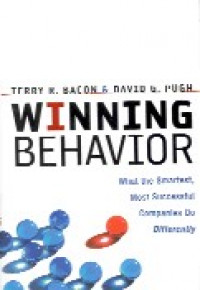
Winning behavior : what the smartest, most successful companies do differently
| Gmd : Text
| Availability :
| 00000009923 | HD58.7 .B3433 2003 | (General Book) | Available - Ada |
In an age where even the best products are quickly imitated, businesses must constantly find new ways to outpace competitors. Successful companies differentiate themselves not just with superior products, but also by how they behave toward their customers at every touchpoint: service, product development, marketing, branding, bids and proposals, presentations, negotiations, and more.
Behavioral Differentiation is emerging as the "final frontier" in competitive strategy, and Winning Behavior shows how leading companies use it to exceed expectations and outperform competitors. This eye-opening book offers case histories and examples from companies like GE, Volvo, EMC, Ritz-Carlton, Wal-Mart, and Harley-Davidson, plus interviews with executives like George Zimmer (Men's Wearhouse), Colleen Barrett (Southwest Airlines), and Gerry Roche (Heidrick & Struggles).
In today's ultracompetitive business landscape, product quality and competitive pricing are prerequisites for staying afloat. Winning Behavior reveals the secrets the best companies use -- and any business can use -- to stay at the pinnacle of success in their industry.
Table of contents
Preface
Acknowledgments
Chapter 1: The Final Frontier
Harley-Davidson's Journey
Differentiating Yourself Through Behavior
Chapter 2: We Will Assimilate You
The Entropic Action of Markets
The Dynamics of Differentiation
The Nine Domains of Differentiation
1. Product Uniqueness
2. Distribution
3. Product Market Segmentation
4. Customer Service/After-Sales Service
5. Breadth of Offerings
6. Brand
7. Size/Market Dominance
8. Low Price
9. Behavior
Chapter 3: You Are How You Behave
What Customers Expect
Gaining Ground-Positive Behavioral Differentiation
Losing Ground-Negative Behavioral Differentiation
Why Positive Differentiating Behaviors Are Difficult to Imitate
Chapter 4: The Four Ways to Create Behavioral Differentiation
The Four Types of Behavioral Differentiation
Operational Behavioral Differentiation: Setting a New Standard
Positive Operational Behaviors
Normal or Expected Server Behaviors
Negatively Differentiating Server Behaviors
Positively Differentiating Server Behaviors
Negative Operational Behaviors
Interpersonal Behavioral Differentiation: Showing That You Care Exceptional Behavioral Differentiation: Breaking the Rules
Positive Exceptional Behaviors
Negative Exceptional Behaviors
Symbolic Behavioral Differentiation: Walking the Talk
Positive Symbolic Behaviors
Negative Symbolic Behaviors
The Relationships Among the Types of Be zavioral Differentiators
Chapter 5: The Gold Standards in Behavioral Differentiation Ritz-Carlton's Gold Standards
Recruiting and Selection
Employee Orientation and Continuing Education
The Daily Lineup
Purpose Over Function-and the Authority to Resolve Problems
The Management of Measurement
Tom's and Shane's Trip from Hell
The World's Most Customer-Centric Company
How EMC Differentiates Itself
EMC's Unique Services Model
Customer Service as an Investment
Raid Escalation of Problems
Global Service Deployment
Phone-Home Capability
Guilty Until Proven Innocent
Change Control Without a Hitch
Measuring Customer Satisfaction
Helping Save Customers' Businesses After 9/11
Chapter 6: Random Acts of Kindness
What People Want
The Bell Curve of Interpersonal Behavior
Chainsaw Al and the Queen of Mean
Other Examples of Negative Behavioral Differentiation
The Jackass Defense
A Tale of Two Captains
The Best Damn Ship in the Navy
Chapter 7: Exceptional Values
The Missing Suitcase
An Important Proposal
Preparing for the Olympic Games
Getting Mutzy into Australia
The Value of Medarbetarskap
Suits and Servant Leadership
Behavioral Differences at Men's Wearhouse
A Web Site with Soul
Emotional Intelligence in Action
Representing the Customer
Exceptional BD at Men's Wearhouse
Why Doesn't Everybody Do It?
Chapter 8: Living the Promise
GAT's Competitive Challenges
The Consultant from Houston
The Selection Process
The Think Tank
The Summary Design
Drum Roll, Please
The Power of Symbolic Behaviors
Harley-Davidson and the Experience Business
Walking the Talk with God
Chapter 9: The Engines That Drive Behavioral Differentiation
The Leadership Engine
The Culture Engine
The Process Engine
The Drivers of Negative Behavioral Differentiation
Institutional Narcissism
Institutional Greed
Institutional Insularity
Institutional Schizophrenia
Institutional Scapegoating
Our Expectations of Managers
Chapter 10: Why Southwest Airlines Soars: B2C Behavioral
Differentiation
The Behavioral Differences at Southwest Airlines
The Customer Service Business
Operations as Internal Customer Service
The Southwest Spirit
Hire for Attitude, Train for Skill
Leaders tip Bench Strength
Places in the Heart
Living the Golden Rule
The Culture Committee
From Customer Loyalty to Customer Advocacy
The Behavioral Difference After September 11
B2C Behavioral Differentiation
Chapter 11: Searching for Stars: B2B Behavioral
Differentiation
Going the Extra Mile at Hall Kinion
Hall Kinion's Differentiation Strategies
Hiring Employees
Recruiting Consultants and Candidates
Differentiating HK with Customers
Hall Kinion University
Building the World's Finest Leadership Teams
The Moment-by-Moment Differences
Just Fire Me Today
Visionaries of Total Human Capital Management
Caring as a Way of Being
Chapter 12: Creating and Sustaining Behavioral
Differentiation
Lessons Learned from Companies That Exemplify BD
The Secret to Creating and Sustaining Behavioral Differentiation
Why You Should Care About Behavioral Differentiation
Products
Price
Behavior
Index
About the Author
Terry R. Bacon (Durango, CO) is the author of Selling to Major Accounts (0-8144-0462-6) and dozens of other books and publications, and the cofounder and president of Lore International Institute. David G. Pugh (Durango, CO) is cofounder and executive vice president of Lore and a recognized authority on marketing, sales, and proposal training.
| Series Title |
-
|
|---|---|
| Call Number |
HD58.7 .B3433 2003
|
| Publisher Place | New York |
| Collation |
xv, 352p.; 24cm.
|
| Language |
English
|
| ISBN/ISSN |
0814471633
|
| Classification |
HD58.7
|
| Media Type |
-
|
|---|---|
| Carrier Type |
-
|
| Edition |
-
|
| Subject(s) | |
| Specific Info |
-
|
| Statement |
-
|
| Content Type |
-
|
No other version available







